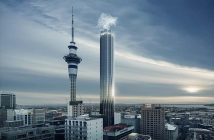Engineers have completed hundreds of rapid assessments and developed a profile of Wellington buildings that suffered the most damage in the Kaikoura earthquake or are susceptible to a similar future event, says New Zealand Society for Earthquake Engineering (NZSEE) president Peter Smith.
The Wellington City Council is being proactive in requiring all buildings fitting this profile to have targeted evaluations, he believes. “We fully support the measures that the council is taking.” The buildings that need targeted evaluation share key characteristics. “These include being medium height and having concrete frames with precast floors,” Smith explains.
“Other characteristics include being sited on soft soils or ridgelines, having significant damage to non-structural elements, demonstrating signs of stretch in carpet tiles or ceilings, or damage to façades.” The quake has generated severe shaking in buildings with these characteristics. “Some of these buildings have been tested beyond their design loadings.” Structural Engineering Society (SESOC) president Paul Campbell says engineers now understand that damage from the Kaikoura earthquake in Wellington was highly selective. “As well as carrying out hundreds of assessments, engineers have been working hard to analyse emerging patterns of damage across Wellington buildings.” The targeted damage evaluations mandated by the council will involve reviewing structural drawings and are likely to be invasive.
This means potentially taking up some floor coverings, stripping off selected wall linings and inspecting ceiling spaces to look for specific patterns of damage. “How long it takes depends on the size of the building and availability of drawings but you would normally expect the inspection component to be completed in a day.”
Institution of Professional Engineers New Zealand chief executive Susan Freeman-Greene says engineers remain concerned about public safety in and around buildings categorised as earthquake prone, given the current heightened risk of aftershocks. “The energy of the Kaikoura earthquake wasn’t focused on shorter, stiffer buildings, some of which are categorised as earthquake prone,” she notes. “It’s important to realise that earthquake-prone buildings are likely to perform poorly in an earthquake centred closer to Wellington.” Freeman-Greene says structural engineers are being brought in from outside Wellington to help meet current demand. “IPENZ appreciates the close collaboration between the council and the engineering profession.”



